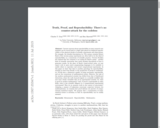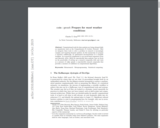
Current concerns about reproducibility in many research communities can be traced back to a high value placed on empirical reproducibility of the physical details of scientific experiments and observations. For example, the detailed descriptions by 17th century scientist Robert Boyle of his vacuum pump experiments are often held to be the ideal of reproducibility as a cornerstone of scientific practice. Victoria Stodden has claimed that the computer is an analog for Boyle’s pump – another kind of scientific instrument that needs detailed descriptions of how it generates results. In the place of Boyle’s hand-written notes, we now expect code in open source programming languages to be available to enable others to reproduce and extend computational experiments. In this paper we show that there is another genealogy for reproducibility, starting at least from Euclid, in the production of proofs in mathematics. Proofs have a distinctive quality of being necessarily reproducible, and are the cornerstone of mathematical science. However, the task of the modern mathematical scientist has drifted from that of blackboard rhetorician, where the craft of proof reigned, to a scientific workflow that now more closely resembles that of an experimental scientist. So, what is proof in modern mathematics? And, if proof is unattainable in other fields, what is due scientific diligence in a computational experimental environment? How do we measure truth in the context of uncertainty? Adopting a manner of Lakatosian conversant conjecture between two mathematicians, we examine how proof informs our practice of computational statistical inquiry. We propose that a reorientation of mathematical science is necessary so that its reproducibility can be readily assessed.
- Subject:
- Mathematics
- Social Science
- Material Type:
- Reading
- Author:
- Ben Marwick
- Charles T. Gray
- Date Added:
- 11/13/2020
